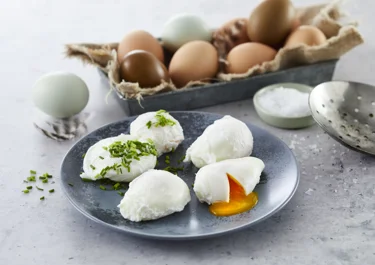Poached eggs

Few breakfast elements seem as fancy and elegant as a poached egg. Many are somewhat intimidated by the idea of trying it out at home, but there is no need to be. With a few easy tricks, you can be cooking beautifully poached eggs in no time. A tasty, soft egg with a runny yolk wrapped in firm egg white has many scrumptious uses, so try our easy poached egg recipe to perfect the technique and enjoy a perfect poached egg as part of a wonderful breakfast or lunch.
Ingredients
|
Water
|
1 litre |
|---|---|
|
Vinegar
|
50 ml |
|
Coarse salt
|
1 tsp |
|
Eggs
|
6 |
Instructions
Tips
Poaching eggs perfectly is easier with cold, fresh eggs. A great way to check if your eggs are fresh is to place them into a bowl with cold water and observe how they behave. As eggs age, air builds up inside of them, increasing their buoyancy.
Tips
Fresh eggs quickly sink to the bottom, where they will lay on their sides. If the eggs sink but stand on their smallest end, they are not quite fresh but still good enough to eat. Eggs that float should be thrown out.
Questions about poached eggs
Poaching eggs is a great way of cooking this breakfast and lunch staple in a way that leaves the yolk nice and runny. To learn more about poached eggs, read our answers to the most frequently asked questions about them below.
What is a poached egg?
A poached egg has been delicately cooked in boiling water outside its shell. Since they are not cooked for long, poached eggs have runny yolks. They are often used to make dishes like Eggs Benedict or Florentine. You can also serve poached eggs on toast with salty and crunchy toppings to balance the mildness of the egg and toasted bread. An avocado toast with poached egg and bacon has quickly become a café classic that may easily be prepared in the comfort of your kitchen.
How to make poached eggs?
Learning how to poach eggs can be a great way to impress guests and family members with tasty, decorative dishes. Fortunately, it is not too difficult. One important trick is to cook the eggs in water containing vinegar. Before transferring the cracked eggs to the boiling water, you should create a whirlpool that together with the vinegar in the water will help the yolk and white stay together. Cook for 3 minutes before stopping the cooking process by popping them into ice-cold water for 30 seconds. Serve the warm poached eggs in your preferred manner while they are still warm and the yolk runny.
How long to cook a poached egg?
The cooking time for a poached egg depends on how you cook it. Cooked in water with vinegar, they should be perfect after about 3 minutes, while it may take up to 5 minutes to cook them if you are wrapping the cracked eggs in cling film instead of using the whirlpool and vinegar trick. Reheating poached eggs made ahead of time is possible but may firm up the eggs and cook their yolks. If you heat them gently by placing them in a small bowl or cup with warm water for 20-30 seconds, though, it should be possible to retain the runny yolk.
How much vinegar to use for poached eggs?
About 50 ml of vinegar mixed with 1 litre of water should be enough to poach unshelled eggs perfectly. The acidic vinegar helps the egg whites coagulate faster and keep together, helping the eggs keep their shape. The small amount does not transfer any tangy flavour to the eggs. However, adding too much may do so – so be sure to measure the amount you add.
Make a perfect poached egg for breakfast or brunch
A runny poached egg is a fantastic choice for a wide variety of different dishes to serve for breakfast, brunch, or lunch. Its texture is beautifully soft in a way that is unlike even soft-boiled eggs. Unlike a fried egg, you do not get any flavouring from either butter or oil, leaving you with a pure flavour from mild-tasting whites and rich, buttery yolks that are still velvety soft and fluid.
The secret: vinegar and a whirlpool
Knowing the secret to poached eggs is the way to make it perfect every time. And the secret is adding vinegar and creating a whirlpool before adding the cracked egg because cracking the egg before poaching ensures that the yolk and white stay together.
Cooking a poached egg with vinegar added to the water is an easy way of ensuring that it holds its shape as you cook it. The acidic vinegar makes the egg whites coagulate and cook faster, so they are fully cooked while the yolks reaming runny.
Using a whisk to create a whirlpool is the last step before adding the egg. The swirling motion created by using this whirlpool method will prevent the egg whites from separating and will help them wrap gently around the yolks.
Delicious ideas for serving
One of the most well-known dishes to feature poached eggs is perhaps Eggs Benedict. This popular brunch dish, which traditionally pairs the egg with meaty bacon and a creamy hollandaise sauce, is delightfully rich.
A simple poached egg toast made with either malty Danish rye bread or crunchy sourdough bread is also a tasty way of serving it.
You can also place a poached egg on salad leaves or steamed asparagus and let the goodness from its creamy, runny yolk serve as a kind of decadent dressing. A recipe for poached egg salad will often feature slightly bitter salad varieties like frisée, spinach, and rocket as these pair well with the egg's richness.
Poached egg on toast with avocado
The combination of smashed avocado and poached egg is deliciously rich and creamy. Often garnished with chilli flakes for heat or chopped chives for freshness, a poached egg on avocado toast makes for a great breakfast, lunch, or brunch dish that is also decorative enough to be served for guests.
Find inspiration on how to pair poached egg and avocado with our avocado toast recipe.
Ramen with poached egg
Another contender for the best poached egg recipe may be an egg-topped ramen soup. These Japanese soups are true flavour bombs and usually feature a tasty broth with meat or mushrooms for umami flavour, a selection of crunchy vegetables, and a quick poached egg to round out the dish. The combination is nothing short of mouth-watering and definitely something you should not miss.
Try another method
If you want to cook your poached eggs without thinking about vinegar or whirlpools, you can use the cling film method to achieve the same soft texture and runny yolk consistency.
Place pieces of cling film in small glasses so it makes a kind of bowl in the glass. Grease the film with a flavour-neutral oil or something like truffle oil if you want to add a bit of flavour. Crack the eggs into these film bowls and close them to make small cling film packets.
Place the packets into a pot of boiling water and cook them for about 5 minutes. Take them out of the water, let them drip off for 1 minute or so, and then remove the cling film and serve a batch of easy, perfectly poached eggs.


&format=webp)



&format=webp)

